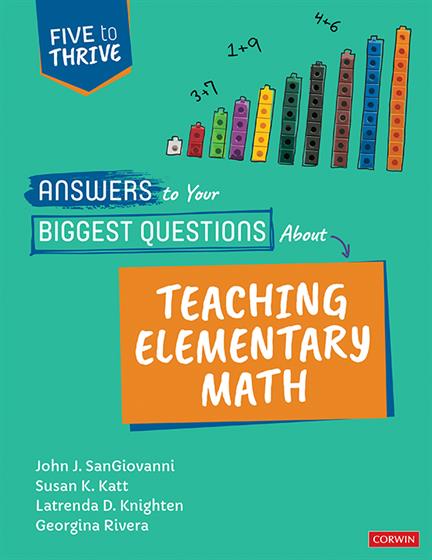Hands-on, Practical Guidance for Educators
From math,
literacy, science, equity, multilingual learners, and SEL, to assessment, school counseling,
and education leadership, our books are research-based and authored by experts
on topics most relevant to what educators are facing today.

Answers to Your Biggest Questions About Teaching Elementary Math
- Grade Level: PreK-4
- ISBN: 9781071857717
- Published By: Corwin
- Series: Corwin Mathematics Series
- Year: 2021
- Page Count: 232
- Publication date: January 15, 2022
Review Copies
Review copies may be requested by individuals planning to purchase 10 or more copies for a team or considering a book for adoption in a higher ed course. Request review copy
Description
Let’s face it, teaching elementary math can be hard. So much about how we teach math today may look and feel different from how we learned it. Today, we recognize placing the student at the center of their learning increases engagement, motivation, and academic achievement soars. Teaching math in a student-centered way changes the role of the teacher from one who traditionally “delivers knowledge” to one who fosters thinking. Most importantly, we must ensure our practice gives each and every student the opportunity to learn, grow, and achieve at high levels, while providing opportunities to develop their agency and authority in the classroom which results in a positive math identity.
Whether you are a brand new teacher or a veteran, if you find teaching math to be quite the challenge, this is the guide you want by your side. Designed for just-in-time learning and support, this practical resource gives you brief, actionable answers to your most pressing questions about teaching elementary math. Written by four experienced math educators representing diverse experiences, these authors offer the practical advice they wish they received years ago, from lessons they've learned over decades of practice, research, coaching, and through collaborating with teams, teachers and colleagues—especially new teachers—every day.
Questions and answers are organized into five areas of effort that will help you most thrive in your elementary math classroom:
1. How do I build a positive math community?
2. How do I structure, organize, and manage my math class?
3. How do I engage my students in math?
4. How do I help my students talk about math?
5. How do I know what my students know and move them forward?
Woven throughout, you'll find helpful sidebar notes on fostering identity and agency; access and equity; teaching in different settings; and invaluable resources for deeper learning. The final question—Where do I go from here?— offers guidance for growing your practice over time. Strive to become the best math educator you can be; your students are counting on it! What will be your first step on the journey?
Author(s)

John J. SanGiovanni
John J. SanGiovanni is a mathematics coordinator in Howard County, Maryland. There, he leads mathematics curriculum development, digital learning, assessment, and professional development. John is passionate about growing new mathematics leaders in the district and through McDaniel College. In addition to the Figuring Out Fluency series, some of his many Corwin books include Daily Routines to Jump-Start Problem Solving, Grades K–8; Answers to Your Biggest Questions About Teaching Elementary Math; the Daily Routines to Jump-Start Math series; and Productive Math Struggle: A 6-Point Action Plan for Fostering Perseverance. John is a national mathematics curriculum and professional learning consultant who also speaks frequently at national conferences and institutes. He is active in state and national professional organizations, recently serving on the board of directors for the National Council of Teachers of Mathematics (NCTM) and on the board of directors for NCSM.

Susie Katt
Susie Katt is the K-2 Mathematics Coordinator in Lincoln, Nebraska, where she leads professional learning, assessment, and math curriculum development. She is an author of Productive Math Struggle: A 6-Point Action Plan for Fostering Perseverance and Answers to Your Biggest Questions About Teaching Elementary Math. She is also a national math curriculum consultant. Susie speaks at state, regional, and national conferences. She served the National Council of Teachers of Mathematics (NCTM) as the chair of the editorial panel for the journal Teaching Children Mathematics, as department editor for Mathematics Teacher: Learning and Teaching PK–12, and as a member of program committees for annual meetings and regional conferences. Susie was recently elected to the board of directors for the National Council of Supervisors of Mathematics (NCSM) as Regional Director, Central 2.

Latrenda D. Knighten
Latrenda Knighten is President (2024 - 2026) of the National Council of Teachers of Mathematics (NCTM) and a retired Mathematics Supervisor from Baton Rouge, LA. She has been an educator for more than 30 years during which she has been a classroom teacher, science specialist, mathematics coach, instructional coach, and a mathematics content provider. An active member of many professional organizations, Latrenda is a past member of the National Council of Teachers of Mathematics, National Council of Supervisors of Mathematics, and the Benjamin Banneker Association Board of Directors. She is also the co-author of two books: Classroom-Ready Rich Math Tasks, Grades K - 1 and Five to Thrive: Answers to Your Biggest Questions About Teaching Elementary Math, K-5.

Georgina Rivera
Table of Contents
About the Authors
Acknowledgements
Introduction
Chapter 1: How Do I Build a Math Community?
Chapter 2: How Do I Structure, Organize, and Manage My Math Class?
Chapter 3: How Do I Engage My Students in Math?
Chapter 4: How Do I Help My Students Talk About Math?
Chapter 5: How Do I Know What My Students Know and Move Them Forward?
Chapter 6: Where Do I Go From Here?
References
Reviews
"A must-have for new teachers! This book could be called Everything I Should Have Learned in College About Teaching Math. Universities should use this in tandem with Van de Walle: easy to read and well organized to understand how to teach math versus what to teach. It includes countless tips, and the notes throughout about access, agency, and equity are invaluable"Colleen Pollitt
Towson University
"From the Introduction through Chapter 6, this easy-to-read book summarized what all elementary math teachers should know and do. The ideas and suggestions are doable in all of our classrooms. This book will be on my desk as a reference to read as well as share with the teachers I coach. Thank you for reminding this Year 30 teacher of many procedures, practices, and routines that I need to reinstate after the horrendous 2020–2021 School Year!"Laura Vizdos Tomas
School District of Palm Beach County, LearningThroughMath.com
"As a former teacher, and currently as a K–8 principal, I find this book to be an invaluable resource! The book is structured in such a systematic way that it allows the reader to start on page 1 or strategically turn to a chapter that will lend guidance to a specific question or need. The book is a must-read due to its practical application that is grounded in research. As a principal, this book also serves as a tool to assist me in giving valuable feedback to teachers."Scott Gaudet
Greene-Hills School
"As a teacher who just completed her second-year teaching, I can attest that new teachers would benefit greatly from this book. This is an easy-to use answer guide to many questions regarding mathematics teaching principles including building community and engaging students in math talk. It is an invaluable resource for new teachers and anyone who is looking for extra guidance in mathematics instruction."Lauren Cope
Lincoln Public Schools
"What an absolute treasure of a resource this book is! This book should be in every elementary teacher’s class as well as on every building leader’s and coach’s bookshelf! This resource takes the abstract and loftiness out of what we know about best practices in math education and makes it accessible and actionable! I can already envision this book being number one in my toolbox for coaching conversations! Thank you!"Elise Paone Archibald
Consolidated School District of New Britain, Connecticut
"Answers to Your Biggest Questions About Teaching Elementary Math: Five to Thrive is a delightful game-changing instructional playbook for new teachers and those of us who want to be effective at cultivating a love for math in the students we serve. This will be the companion of teachers of math for years to come. Read this book, and gain tools to thrive."Sharon C. Thomas
East Baton Rouge Parish School System
"Developing a formula for success in mathematics teaching and learning can take decades of experience and study, especially for elementary educators. Yet the authors have encapsulated it in this easy-to-read book through an honest and practical approach. A must-have resource for every mathematics educator!"Tara Fulton
Crane School District
"A practical how-to resource for cognitively engaging educators in crafting a math community with students at the center! Through examples and non-examples, activities, and specific and intentional guiding questions, no stone was left unturned in how to structure, engage, and move students forward in a math community!"Kellie Joy
Lincoln Public Schools
"The authors offer fresh and pragmatic insights into teachers’ biggest questions related to building community, classroom structure and management, engagement, discourse, and assessment in elementary mathematics. This is a must-read resource for teachers and math coaches committed to the effective teaching of mathematics and the pursuit of deep learning!"Sorsha-Maria T. Mulroe
Running Brook Elementary
"Answers to Your Biggest Questions About Teaching Elementary Math: Five to Thrive addresses the “how-to”s of establishing a culturally responsive, student-centered, rigorous, inclusive mathematics classroom. From how not to “hijack a lesson” to how to support students when they are stuck, it provides thorough rationales for the research-based practices it promotes. This book can be a reference guide for new teachers and those transitioning away from the traditional methods of teaching mathematics."Karen Riley Jeffers
Prince George’s County Public Schools
"Answers to Your Biggest Questions About Teaching Elementary Math: Five to Thrive is a must-read for new and experienced math teachers alike! Learn how to develop a strong mathematics community—a community that includes everyone, from the ground up. This will be a nice book to keep on hand and refer back to throughout the year."Lukas Hefty
Pinellas County Schools, Florida
"Working to ensure all students have access to high-quality math instruction at the elementary level raises a number of questions for educators. In clear, easy-to-read, and practical terms, the authors effectively outline essential components and strategies to guide educators in fostering a student-centered approach to mathematics instruction that gives all students the agency to be successful “doers” of mathematics. This must-have book provides illuminating examples of best practices, sound tips and resources, and authentic samples of student work to showcase key methods and ideas that are grounded in research and, most importantly, classroom tested."Ann Marie Spinelli
Central Connecticut State University
"Answers to Your Biggest Questions About Teaching Elementary Math: Five to Thrive is a must-read question-and-answer guide for mathematics educators and leaders. The authors paint a vivid picture of student-centered instruction and share how to implement mathematics instructional shifts to prepare students for a future in which they can reason, think critically, and become doers of mathematics."Mona Toncheff
As an instructional coach, I will be recommending this book to every teacher I coach. The format is user-friendly and the content is extraordinary! This book answers questions I hear from teachers every day. What's the best way to make anchor charts? How do I organize my math block? How do I make math student-centered? How do I plan for small group instruction? These and other pertinent questions are answered with best practice, culturally relevant, growth mindset, and mathematical practices in mind. I am looking forward to using this for a book study with several groups of teachers I coach! Game-changer!Gail Donahue, Ph.D. (Instructional Coach)
Notre Dame of Maryland University
Review Copies
Review copies may be requested by individuals planning to purchase 10 or more copies for a team or considering a book for adoption in a higher ed course. Request review copy
Related Professional Learning
Related WebinarsRelated Resources
-
How Do I Teach Problem Solving?
[Lessons and Strategies] -
How to Nurture Math Identity
[Lessons and Strategies] -
What to Look For as Students Work
[Lessons and Strategies]
Join us for the Visible Learning
Conference in Las Vegas!
Experience groundbreaking research, inspiring speakers,
and transformative networking. Register Now.

